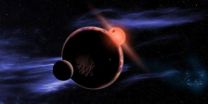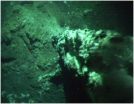(Press-News.org) Using publicly available data from NASA's Kepler space telescope, astronomers at the Harvard-Smithsonian Center for Astrophysics (CfA) have found that six percent of red dwarf stars have habitable, Earth-sized planets. Since red dwarfs are the most common stars in our galaxy, the closest Earth-like planet could be just 13 light-years away.
"We thought we would have to search vast distances to find an Earth-like planet. Now we realize another Earth is probably in our own backyard, waiting to be spotted," said Harvard astronomer and lead author Courtney Dressing (CfA).
Dressing presented her findings today in a press conference at the Harvard-Smithsonian Center for Astrophysics in Cambridge, Mass.
Red dwarf stars are smaller, cooler, and fainter than our Sun. An average red dwarf is only one-third as large and one-thousandth as bright as the Sun. From Earth, no red dwarf is visible to the naked eye.
Despite their dimness, these stars are good places to look for Earth-like planets. Red dwarfs make up three out of every four stars in our galaxy for a total of at least 75 billion. The signal of a transiting planet is larger since the star itself is smaller, so an Earth-sized world blocks more of the star's disk. And since a planet has to orbit a cool star closer in order to be in the habitable zone, it's more likely to transit from our point of view.
Dressing culled the Kepler catalog of 158,000 target stars to identify all the red dwarfs. She then reanalyzed those stars to calculate more accurate sizes and temperatures. She found that almost all of those stars were smaller and cooler than previously thought.
Since the size of a transiting planet is determined relative to the star size, based on how much of the star's disk the planet covers, shrinking the star shrinks the planet. And a cooler star will have a tighter habitable zone.
Dressing identified 95 planetary candidates orbiting red dwarf stars. This implied that at least 60 percent of such stars have planets smaller than Neptune. However, most weren't quite the right size or temperature to be considered truly Earth-like. Three planetary candidates were both warm and approximately Earth-sized. Statistically, this means that six percent of all red dwarf stars should have an Earth-like planet.
"We now know the rate of occurrence of habitable planets around the most common stars in our galaxy," said co-author David Charbonneau (CfA). "That rate implies that it will be significantly easier to search for life beyond the solar system than we previously thought."
Our Sun is surrounded by a swarm of red dwarf stars. About 75 percent of the closest stars are red dwarfs. Since 6 percent of those should host habitable planets, the closest Earth-like world is likely to be just 13 light-years away.
Locating nearby, Earth-like worlds may require a dedicated small space telescope, or a large network of ground-based telescopes. Follow-up studies with instruments like the Giant Magellan Telescope and James Webb Space Telescope could tell us whether any warm, transiting planets have an atmosphere and further probe its chemistry.
Such a world would be different from our own. Orbiting so close to its star, the planet would probably be tidally locked. However, that doesn't prohibit life since a reasonably thick atmosphere or deep ocean could transport heat around the planet. And while young red dwarf stars emit strong flares of ultraviolet light, an atmosphere could protect life on the planet's surface. In fact, such stresses could help life to evolve.
"You don't need an Earth clone to have life," said Dressing.
Since red dwarf stars live much longer than Sun-like stars, this discovery raises the interesting possibility that life on such a planet would be much older and more evolved than life on Earth.
"We might find an Earth that's 10 billion years old," speculated Charbonneau.
The three habitable-zone planetary candidates identified in this study are Kepler Object of Interest (KOI) 1422.02, which is 90 percent the size of Earth in a 20-day orbit; KOI 2626.01, 1.4 times the size of Earth in a 38-day orbit; and KOI 854.01, 1.7 times the size of Earth in a 56-day orbit. All three are located about 300 to 600 light-years away and orbit stars with temperatures between 5,700 and 5,900 degrees Fahrenheit. (For comparison, our Sun's surface is 10,000 degrees F.)
INFORMATION:
Earth-like planets are right next door
2013-02-06
ELSE PRESS RELEASES FROM THIS DATE:
Study: Firms that purport to value shareholders pay CEOs more
2013-02-06
CHAMPAIGN, Ill. — Ever wonder why CEOs at poorly performing companies continue to receive exorbitant pay packages? According to a study from a University of Illinois labor professor, firms that trumpet how much they value shareholders actually pay their CEOs more, regardless of the quality of their performance as executives.
Using compensation data from 290 chief executives at large U.S. firms over an 11-year period, Taekjin Shin, a professor of labor and employment relations at Illinois, shows that CEOs at firms with the appearance of a "shareholder-value orientation" ...
Environmental factors determine whether immigrants are accepted by cooperatively breeding animals
2013-02-06
Cichlid fish are more likely to accept immigrants into their group when they are under threat from predators and need reinforcements, new research shows. The researcher suggests that there are parallels between cooperatively breeding fish's and humans' regulation of immigrants. The research was published today, 6 February 2013, in the journal Proceedings of the Royal Society B.
The Princess of Lake Tanganyika (Neolamprologus pulcher), a cichlid fish which is popular in home aquariums, are cooperatively breeding fish with a dominant breeding pair and several 'helper' ...
Nothing fishy about swimming with same-sized mates
2013-02-06
Have you ever wondered why, and how, shoals of fish are comprised of fish of the same size? According to new research by Ashley Ward, from the University of Sydney in Australia, and Suzanne Currie, from Mount Allison University in Canada, fish can use a variety of different sensory cues to locate shoal-mates, but they are able to use chemical cues to find other fish of the same size as themselves. Using these cues, they can form a group with strength in numbers. The work is published online in Springer's journal, Behavioral Ecology and Sociobiology.
Forming groups is ...
Biocontrol research on Brazilian peppertree in Florida discovers new cryptic species
2013-02-06
Dr Michael Pogue, a Research Entomologist in the ARS Systematic Entomology Laboratory, at the Smithsonian Institution, Washington, DC, was sent a series of moth specimens from Bahia, Brazil, for identification. The insects were under consideration as a possible biocontrol agent for the invasive Brazilian peppertree in Florida.
'The species was initially identified as a common species, but when comparisons were made, it became evident that there were multiple species involved' said Dr. Pogue. Using characters from the moths' male and female genitalia, Dr. Pogue determined ...
Widely used nanoparticles enter soybean plants from farm soil
2013-02-06
Two of the most widely used nanoparticles (NPs) accumulate in soybeans — second only to corn as a key food crop in the United States — in ways previously shown to have the potential to adversely affect the crop yields and nutritional quality, a new study has found. It appears in the journal ACS Nano.
Jorge L. Gardea-Torresdey and colleagues cite rapid increases in commercial and industrial uses of NPs, the building blocks of a nanotechnology industry projected to put $1 trillion worth of products on the market by 2015. Zinc oxide and cerium dioxide are among today's most ...
Study of a rare disease making people look like a woman but having male genitals under study
2013-02-06
University of Granada researchers have designed a guideline for physicians and patients on the Androgen Insensitivity Syndrome (AIS), a rare disease that makes the subject develop reverse sex, which occurs when a subject looks like a woman but has male genes.
AIS has low prevalence (it only affects one in 2000 people), and it is characterized by the inability of tissues to respond to the action of male hormones. This prevents individuals with XY sex hormones (i.e. 46,XY) to develop male genitalia. This disorder is caused by a mutation in the gene that codifies the receptor ...
Being overweight linked to higher risk of gum disease
2013-02-06
CHICAGO (Feb. 6, 2013)—Impacting approximately one-third of the U.S. population, obesity is a significant health concern for Americans. It's a risk factor for developing type 2 diabetes, heart disease, and certain forms of cancer, and now, according to an article published in the January/February 2013 issue of General Dentistry, the peer-reviewed clinical journal of the Academy of General Dentistry (AGD), it also may be a risk factor for gum disease.
"We know that being overweight can affect many aspects of a person's health," says Charlene Krejci, DDS, MSD, lead author ...
The European Space Sciences Committee reacts
2013-02-06
European Science Foundation's ESSC comments the decisions taken (or not) at ESA's council meeting at ministerial level.
Strasbourg – 6, February, 2013 - The European Space Sciences Committee (ESSC) today released its position on the perspectives for the European Space Agency's (ESA) scientific programmes. The position statement provides recommendations on the outcomes of the ESA council meeting at ministerial level, which took place on 26-27 November 2012 in Naples.
The statement comments on the impact for science-relevant ESA's programmes resulting from the decisions ...
Learning from the linker
2013-02-06
Mature cells can be reprogrammed to pluripotency and thus regain the ability to divide and differentiate into specialized cell types. Although these so-called induced pluripotent stem cells (iPS cells) represent a milestone in stem cell research, many of the biochemical processes that underlie reprogramming are still not understood. Scientists from the EMBL Hamburg and from the Max Planck Institute for Molecular Biomedicine in Münster, Germany now shed new light on this process. In a study published today in Nature Cell Biology, the scientists describe important details ...
Shimmering water reveals cold volcanic vent in Antarctic waters
2013-02-06
The location of an underwater volcanic vent, marked by a low-lying plume of shimmering water, has been revealed by scientists at the National Oceanography Centre, Southampton.
Writing in the journal PLOS ONE the researchers describe how the vent, discovered in a remote region of the Southern Ocean, differs from what we have come to recognise as "classic" hydrothermal vents. Using SHRIMP, the National Oceanography Centre's high resolution deep-towed camera platform, scientists imaged the seafloor at Hook Ridge, more than 1,000 metres deep.
The study, funded by the ...



